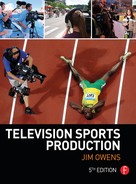Chapter 2
Television Sports Personnel
Quality must be applied to all of our work. I believe this to mean that we have to tap into our passion for what we do. To continue to be inspired and challenged by the work of others. To be educated and forward-thinking as much as possible. And, ultimately, not to rest on success but flourish by challenging failure. In essence, we have to become the best fans possible.
Daniel Silver, Director of Development, ESPN Films
Understanding how the remote production goes together requires the understanding of the role of each of the participants, their responsibilities, and how they interact. Respon sibilities vary with the production company, station, network, and event. People are often required to wear multiple hats in a single production.
The Producer
Producers give the sportscast its viewpoint, its flavor. The best producers are master painters, Picassos or Rembrandts. The mechanics of their profession—the hows and whens to use different brush strokes—are second nature to them so they are able to rise to another level, combining the individual strokes to create a masterpiece that interprets the world in a unique way. The best producers have the mechanics down cold so they are free to develop a storyline, using the talents of the broadcast crew as their brushes. Good producers have three common characteristics:
- (1) they are organized;
- (2) they are cool under pressure; and
- (3) they respect and support the broadcast team working with them.
Gary Bender,
Former Sportscaster for Fox Sports
Additionally, the name of production functions may vary from company to company. While it is difficult to give a definitive description of each position, the following is a brief description of the most common roles within a remote sports crew.
Personnel Descriptions
I’ve always maintained that with the right crew (producer, director, play-by-play commentator, and analyst) you can make a toenail clipping competition riveting television. With the wrong crew you can make an FA Cup boring.
David Hill, CEO, Fox Sports Media Group
Executive Producer (Head of Production):
Responsible for the planning and logistics of one production or a series of productions. Gives overall vision for a production or a series of productions. The executive producer’s responsibilities generally include finance, scheduling, and sometimes major creative decisions. Other responsibilities may include negotiating with sport organizations on rights, camera placement, and event coverage, and they may oversee a number of producers or coordinating producers.
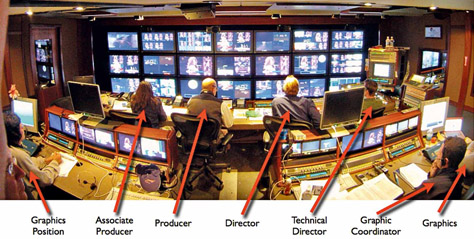
Figure 2.1
Crew members in a remote production truck.
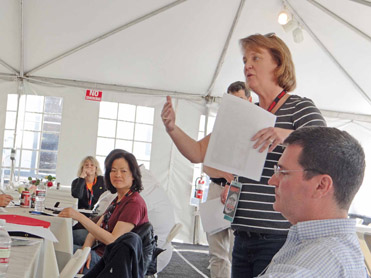
Figure 2.2
Director Pat Lowry (standing) leads a meeting of camera and EVS operators to discuss logistics of an event.
Source: Photo courtesy of SVG.
Coordinating Producer:
Keeps track of budgets, quality control, and logistics for multiple producers. The coordinating producer may also be responsible for the overall look and elements, such as animation and graphics. Reports to the executive producer or the head of production.
Producer:
Responsible for planning and logistics before the event. The producer works with the director to implement the overall production plan. Together, they are responsible for overseeing all elements of the production of an event. During the production, the producer is responsible for coordinating the commercials, calling the replays, and making sure that the needs of the talent are met, in addition to keeping the production within budget and on schedule. Reports to the executive producer or coordinating producer (see Figure 2.1).
Preparing for the Game
Ultimately the key to NBC’s successful basketball playoff coverage lies not so much with its equipment and technology as it does with the mental preparation of the director and crew. Our coverage really begins by spending time with the players, coaches, and announcers, learning what the stories are and studying the game. I’m watching NBA basketball literally every night of the week during the season, learning about the players, their moves, their team’s style of play. People say, “Oh you just work during the broadcast” but I’ll prep all week for that broadcast and I’m prepping the whole season for the playoffs.
Andy Rosenberg,
Director, winner of 15 Emmy Awards
Creating Magic
For all the engineering, operations, and production services planning that go into an Olympics, we only provide the tools for production guys to come in and create the magic. It takes the production guys and the people in front of the camera and us behind the camera to pull off a successful telecast.
David Mazza,
Senior Vice President and Chief Technical Officer, NBC Sports Group and NBC Olympics
Hiring Personnel
When we hire, we are looking for more than just the most qualified people we can find. We need people who understand how their role fits into the bigger picture, who respect the fact that they may be a guest in different culture, and who are adaptable and can work under pressure in a fast-paced, unforgiving and constantly changing environment. People who can meet these qualifications will be successful in television sports production.
Hank Levine,
CFO, Olympic Broadcasting Services
Associate Producer/Assistant Producer (AP):
The AP is given specific producing responsibilities by the producer or executive producer. This person often supervises postproduction and/or the production of edited video packages and teases that appear within a production. The associate producer may be assigned some of the same responsibilities as the associate director. This person is sometimes called a features producer. Reports to the producer.
Features Producer:
See associate producer.
Director:
Under the guidance of the producer, the director is responsible for the creative and aesthetic portions of the production. Directors must know what they want and how they are going to accomplish it. To coordinate the various aspects of the broadcast, they have to understand the capabilities of the equipment and the crew they have been assigned. The director sets the tone and pace of the production and serves as crew motivator. The director must be able to visually tell the story, to document the event in a way that allows the viewers to feel as if they are part of the action. Occasionally, they are also responsible for working with and directing the talent, although this is rare during a sport production. Reports to the producer (see Figure 2.2).
Associate Director/Assistant Director (AD):
Assists the director during the television production by keeping track of timing and making sure that camera shots, graphics, and video recordings are ready for the director’s cue. One of the major responsibilities of the AD is to maintain constant communication with the studio, coordinating commercial breaks by numerically counting back timing cues in order to smoothly segue between two entities. This person may be assigned some of the same responsibilities that an associate producer performs. Generally reports to the director and the producer.
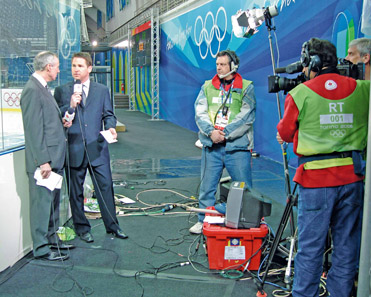
Figure 2.3
The stage manager (middle) coordinates everything with the talent in the field, broadcast booth, or studio.
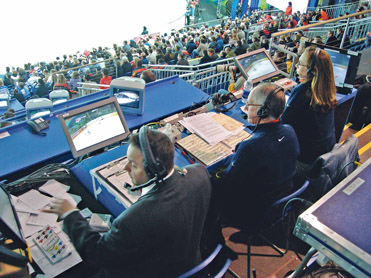
Figure 2.4
Statisticians (left) compile up-to-the-minute statistics that are helpful to the on-air commentators and the production personnel.
Unit Manager:
Handles budgetary operations, including outside vendors and overtime. The unit manager also handles crew scheduling. This position is sometimes merged with the production manager and/or the technical manager. Reports to the producer.
Production Manager / Operations Producer:
Oversees the operation of the production team, including budgets, personnel assignments, transportation, accommodation, coordinating transmission information, and acts as liaison with the venue. Sometimes this job is merged with the unit manager and/or the technical manager. Generally reports to the producer.
Production Coordinator:
Responsible for general operations, such as catering, petty cash, runners, credentials, and phones. This position is sometimes merged with production manager. The production coordinator re ports to the production manager, technical manager, unit manager, or producer.
Stage Manager/Floor Manager:
Coordinates everything occurring in the studio or broadcast booth. The stage manager communicates with hand signals when the talent is on camera and sometimes communicates via cards when off camera. Generally reports to the producer but may report to the director in a remote production (see Figure 2.3).
Production Assistant (PA)/Director’s Assistant:
Handles details for the producer and/or director. These details may include, but are not limited to, overseeing travel arrangements, graphics, show format changes, and distribution of updated information to various staff members. The PA also arranges shipments and pickup/delivery of food, establishes rights to music, supervises runners, and takes care of anything else the producer and/or director need. Generally reports to the producer and sometimes the director.
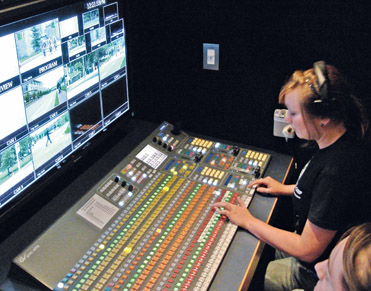
Figure 2.5
The technical director/vision mixer responds to the director.

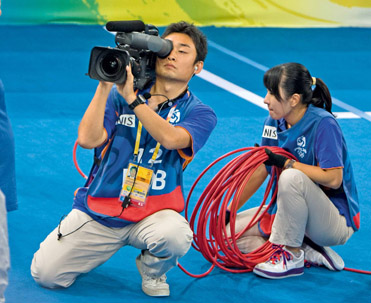
Figure 2.6
There are many different kinds of camera operators. The first image shows a stationary or fixed camera. The second image shows a handheld camera with a camera assistant who is responsible for managing the camera cable.
Spotter:
Advises the production crew regarding important activity or incidents in and around the field of play that may not be immediately evident to the production crew and camera operators. Generally reports to the director.
Statistician:
Compiles competition statistics, including past performances and up-to-the-minute competition details. Also gathers general information about current competition conditions, such as weather. Generally reports to the producer and production assistant (see Figure 2.4).
Replay Assistant Director:
Helps select the appropriate portion of the recording for playback and ensures that recorder operators are cued and ready when the director needs them. Generally reports to the producer.
Technical Director (TD)/Vision Mixer/Vision Switcher:
Takes instructions from the director and, using a special effects generator (SEG) or switcher, switches between video images using cuts, dissolves, wipes, special effects, animation, and graphics, sometimes using multiple cameras at the same time. Reports to the director (see Figure 2.5).
Camera Operator:
Receives assignments from the director and works to constantly provide the director with the best quality images available for the production. Camera operators may also be responsible for transport, setup, and sometimes general maintenance of their camera. Reports to the director (see Figures 2.6a and 2.6b).
Electronic Still Store (ESS) Operator:
Operates equipment used for the capture, storage, manipulation (if needed), and playback of still images from video. Works under the director during the production. Reports to the producer and director.
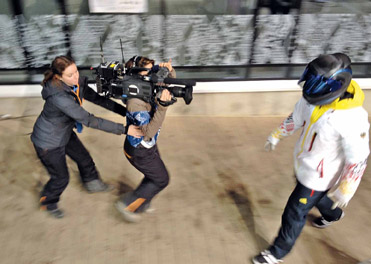
Figure 2.7
Besides managing cables, camera assistants must look out for the camera operator by making sure they are safe, and they may be required to assist in camera shots.
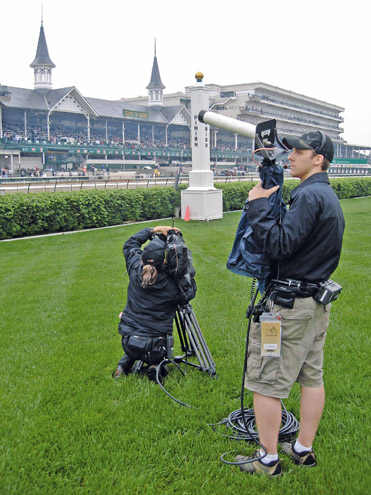
Figure 2.8
Some wireless cameras require an RF (radio frequency) assistant to aim the transmitter at a receiver.
Source: Photo provided by Josh Taber.
Camera Assistant (Handheld, Steadicam, Crane, etc.):
Protects and assists the camera operator by keeping people from walking into the camera’s field of view, eliminating potential obstacles or obstructions, and keeping camera cables untangled and free from traffic. A handheld camera assistant is mainly responsible for reacting to the camera operator’s movement during an event by feeding the operator camera cable during the production. In order to accomplish this feat, the camera assistant has to pay attention and learn the over and under cable coiling method. This method greatly reduces cable tangling and ultimately allows the operator to move freely to react to the task at hand. In addition, the camera assistant may collect food for the camera operator, carry extra batteries, and sometimes work as a spotter, looking for shot possibilities or other happenings that the shooter should know about. The camera assistant may also assist with setup, reposition, and strike of camera equipment. Reports to the camera operator (see Figure 2.7).
RF Assist:
A specific type of camera assistant who is responsible for keeping the RF transmitter (used for wireless cameras) aimed at the RF receiver, as well as preventing the cables between them and the camera operator from becoming tangled or stretched. The RF assist is also responsible for looking out for the camera operator, making sure that no one walks between them or blocks the camera’s field of view. Reports to the camera operator (see Figure 2.8).
Rigger:
Sets up structures to support lighting or camera equipment before the event and then strikes the equipment after the event is completed. Reports to the technical manager.
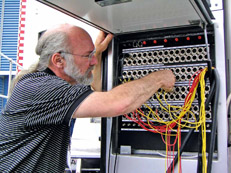
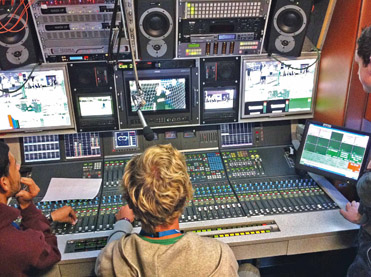
Figure 2.9
The audio supervisor (A-1) is responsible for patch audio in the mobile unit and mixing the show.
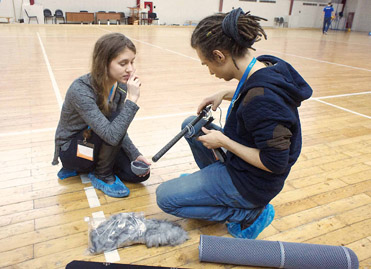
Figure 2.10
A-2s are responsible for setting up and possibly operating the microphones along the field of play.
Source: Photo courtesy of Chris Jensen.
Audio (A-1)/Mixebr/Audio Supervisor:
Deter mines where microphones are to be placed in the field of play, generally patches the various microphones in the inputs/ outputs (I/O) patch panel located on the outside of the mobile unit, gives instructions to the A-2, and sets up and/or patches the PL system in the mobile unit. The A-1 also mixes the audio signal from the various microphones, recorders/players, house feed, and public address system during the actual production. Reports to the producer and the director (see Figure 2.9).
Audio Assistant (A-2):
Receives instruction from the A-1 as to where microphones should be placed on the field of play and sets out the microphones. Other responsibilities may include patching the I/O, assisting the talent with their microphones, and operating microphones on the field of play, such as a parabolic dish or shotgun microphone. The A-2 also troubleshoots audio problems during the production. Reports to the A-1 (see Figure 2.10).
Utility/Grip/Rigger:
Before the actual production, utilities assist the engineering crew by carrying equipment, placing cabling during setup, and assisting during the teardown (strike). During the production, utilities may be reassigned to work as camera assistants or be placed in other support positions. Reports to the technical manager and to whomever else they are assigned during the actual production time (see Figure 2.11).
Video Operator (VO)/Video Engineer / Vision Control / CCU Operator / Shader:
Responsible for adjusting video levels as well as establishing the color intensity of cameras on the camera control unit (CCU) to obtain the highest-quality image. The video operator also works with the engineer-in-charge (EIC) to patch all video sources and phasing/white balance of cameras. Reports to the director and producer (see Figure 2.12).
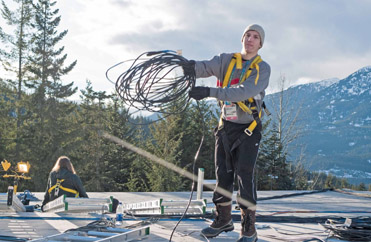
Figure 2.11
The utility assists the engineering staff in setting up and tearing down equipment and cables.
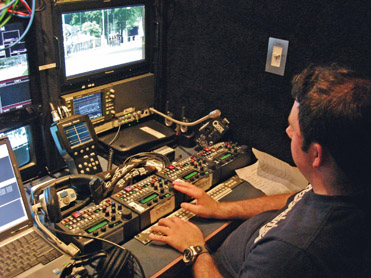
Figure 2.12
Video operators, or shaders, are responsible for adjusting the camera and VTR images to obtain the highest quality possible.
Video Librarian/Archivist:
Collates and maintains the video recordings and record of events ready for retrieval on request. This is accomplished by keeping track of the numeric time code clock displaying the exact time and location on the recordings where the particular action can be found. They may also be responsible for dubbing. Reports to the producer.
Replay Operator (RO)/EVS/Tape Operator (VT):
Runs recorders, monitors audio and video levels, and often operates an auxiliary bus switcher in order to isolate specific cameras on a video recorder. This person may also serve as a slow motion (slo-mo) operator. Reports to the producer and director.
Slo-Mo Operator/Super Slo-Mo Replay Operator:
Operates and maintains slow motion recorders and players. Provides the slomo/super slo-mo replays as required by the director. Reports to the producer and director (see Figure 2.13).
Editor:
Selects, compiles, and cuts video and audio to produce highlights, summaries, and feature packages. Reports to the producer.
Graphics Operator/Font Operator/ Character Generator Operator:
Operates the character generator to put text and graphics on the television screen. Reports primarily to the producer and director (see Figure 2.14).
Font Coordinator:
Assists the graphics/font operator, keeping them up to date during a production. Responsibilities may include spell checking, updating scores, identifying on-screen personnel, etc. The font coordinator is often one of the production assistants. Reports primarily to the producer.
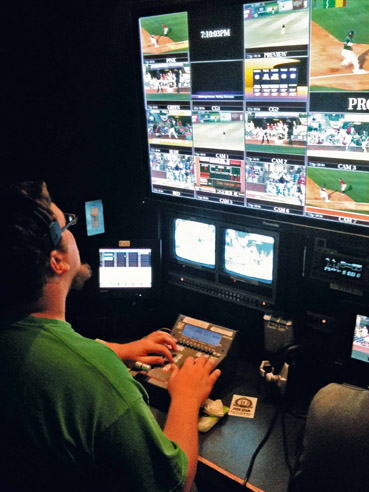
Figure 2.13
Replay operators operate and maintain slow-motion recorders and players.
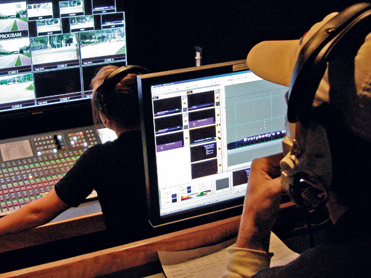
Figure 2.14
Graphics operators must pay very close attention to the director, producer, and the program in order to anticipate what graphic the director is going to call for.
Technical Manager:
Responsible for all broadcast-related technical operations at the venue. Reports primarily to the director.
Engineer-in-Charge (EIC)/Chief Vision Engineer/Senior Vision Operator:
Works for the mobile unit provider and is responsible for keeping everything working in the truck. Also responsible for making sure that all equipment, cables, and supplies that came with the truck are returned to the unit at the end of the shoot. Primarily reports to the technical manager.
Maintenance Engineer:
Maintains production equipment in the truck and on the field of play. Reports to the EIC.
Transmission (TX) Manager/Transmission Operator:
Ensures the quality and continuity of the television signal transmission. Reports to the technical manager.
Telecom Manager/Telco Manager:
Sets up and troubleshoots communication lines (PLs) between the field crew, talent, and the crew in the trucks. Provides and installs telephone lines for outside calls. Reports to the technical manager.
Runner:
Responsible for running errands and completing a variety of tasks assigned by the production assistant, producer, production manager, and almost anyone else on the production. This may include being a driver for personnel, getting food or supplies to the crew in the middle of a shoot, making travel arrangements, and undertaking research. Reports to the production assistant.
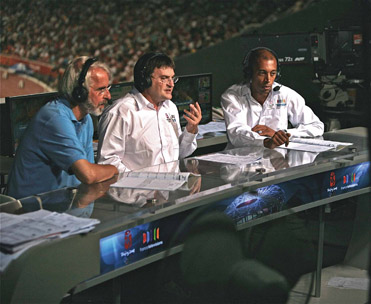
Figure 2.15
The term “talent” usually refers to anyone who appears in front of the camera.
Source: Photo courtesy of France Televisions.
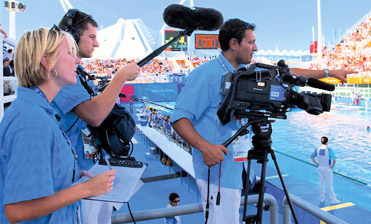
Figure 2.16
Field loggers must list each shot made by an ENG camera operator.
Talent:
Refers to anyone who appears in front of the camera or is heard on air. Reports to the producer (see Figure 2.15).
Field Logger:
Field loggers are responsible for providing detailed written descriptions and time codes for all footage shot by an ENG cameraperson. Logs generally identify all athletes, scores, and results shot. These logs are used by the production personnel to identify time codes and to quickly retrieve footage that can be edited and used in packages. Reports to the producer (see Figure 2.16).
As mentioned earlier, it is very difficult to give an exact definition for each position since responsibilities can vary greatly from event to event and company to company. It is also impossible to create an organizational chart that will fit every situation. The chart in Figure 2.17 shows a common television network structure in a remote sports production.
Freelance Personnel
Today, it is rare to find a remote production crew that does not have at least a few freelance personnel. Some crews are made up almost entirely of freelance personnel. Freelancers are independent contractors who generally work for multiple organizations, hiring out their production skills on an as-needed basis.
Many of the positions defined here can be filled by qualified freelancers as opposed to full-time employees. Freelancers are hired because companies often do not have enough full-time staff to totally crew a remote production. Also, many of the companies that shoot remote productions travel around the region, nation, or world, and the least expensive way to staff the crew is to use local personnel. This way, the company does not need to pay lodging, travel, and a per diem.
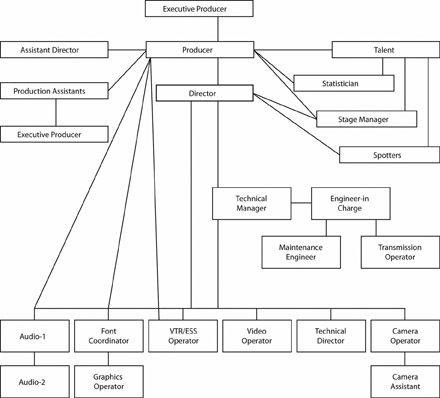
Figure 2.17
Common organizational chart for a network remote sports production crew.
It takes time for freelancers to make the right connections and obtain continual work. However, work is available for skilled freelancers and they can make a good living.
The television industry often relies on verbal commitments when it comes to securing personnel. If the event has fewer than 150 people, contracts are often not issued. Employ ment details are often discussed and finalized over the telephone. For larger events, written contracts are usually issued. Freelance contracts generally include description of service the freelancer will provide, period of engagement, compensation, travel, and accommodation (if needed). Contracts may also include insurance information, a confidentiality statement, an intellectual property statement, and termination information (see Figure 2.18).

Figure 2.18 Freelance personnel often sign some type of contract when working for a production company.
Dateline: Thursday, February 21
The final group of women is about to take the ice for the warm-up of the free skating event at the Olympic Games. The hand-picked team we spent two years putting together is in position.
My top requirements as the director are talent, experience, positive attitude, a sense of humour and the passion to give 100 percent.
We are 13 days in. The programs have been recorded and blocked. I have visualized each shot and screened each top skater’s routine with my camera operators, communicating my vision to them. The producer and the experts in video playback have planned potential replays. The team responsible for the truck, video, audio and graphics has been fine-tuning every step of the way. The TD is standing by for the cues. The skaters are ready for their night. .. and so are we. I am ready to go out onto the edge of the envelope because I trust every member of my team and I know each of them will go there with me.
Sarah Hughes flies through her program and the audience senses that what they are seeing might be the biggest upset in skating history. We are with her every stroke of the way. .. through the two breathtaking triple/triple jump combinations, the graceful inside spiral, her sweeping lay-back spin, and even the brief moment when she looks up midway through her program, right into camera 2. .. we see a tight shot of her face. .. and an expression full of promise. As the music builds and the audience rises to their feet, camera 2 gets the tight shot at the end as she throws back her head with a flourish. Then there is unrestrained jubilation as camera 3 pushes past Sarah’s face to her exuberant coach jumping up and down, with Sarah in the foreground; rack focus. The rack focuses again and pulls back to see Sarah in all her glory. This becomes the replay of the Olympics. But before we roll it in, there are the flowers and the ovations and the heady shots of joy as Sarah leaves the ice. While others cut away to replays, we stay with it live. And then I notice her coach turning her away from “kiss and cry.” Cut from handheld 8 to camera 3. Sarah’s coach is doing something unusual and I know her and I know what she is doing. Camera 3 captures the moment when her coach whispers in her ear as Sarah takes in the cheering arena full to the rafters. We can’t hear her, but we know. She is saying to Sarah: “Remember this. Stop and take this in. Remember this moment for the rest of your life.”
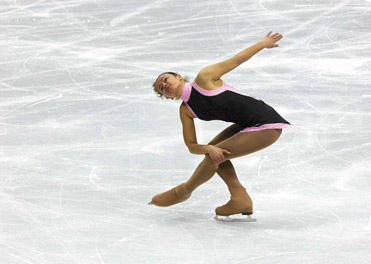
Forty minutes later the last skater has skated and her scores are up. They are not good enough. Sarah Hughes has won the gold and we see her and her coach off in a locker room as they fall to the floor in shock—crying and laughing and hugging each other. Their victory was captured by the only two camera operators allowed inside by the officials, Sarah and her coach to witness this private moment. They were permitted because they had gained their trust over the years by honoring the skaters during their most difficult times. They were there because they were the best—as camera operators and as people. They brought Sarah’s triumphant moment to the world.
It’s over. I walk alone from the truck to the arena to be with my team. As I descend the steep hill, I can see figures in the doorway, backlit from the glow inside. A slow, wide smile spreads across my face. It is my camera team and they are walking and laughing together. It is a stride I recognize.
I call it: “the astronauts walk from The Right Stuff”. .. and they have it, not just the walk but the camaraderie. .. and at that moment I stop and take it in. I am so proud of every member on our team.
Meg Streeter, Director, 12 Olympic broadcasts
Interview: James Stuart, Production Manager

Define your job.
Coordinate overall logistics, facilities, and vendors for network programs. Financial control of show cost budgets. Maintain crew logs and daily schedules. Liaison with various sports leagues, teams, and venues.
What do you like about your job?
Even though I may be working on a specific sport for the entire season, the work is never the same. Each city, venue, or game presents its own unique challenges whether it be logistically, operationally, or production/technical wise. I may be able to have a baseline on how I approach each event, but I need to adjust for the wrinkles each event presents. That keeps it fresh and prevents getting in a cookie cutter rut.
What are the types of challenges that you face in your position?
Challenges come both from work and personal life. You need to be able to balance both. There are times when you will be traveling 4–5 days a week with little time for home life. If you are single, it may not be much of an issue, but if married with kids you need to be sure everyone is on board with your chosen profession. Work challenges will be all the unforeseen last-minute changes that come up. Could be anything from a flight being delayed, bad weather, delay or postponement of game, power outage, adding a camera to the broadcast, or breaking news, whether it’s event-related or other national news.
How do you prepare for a production?
The start to each event begins with a production meeting so you know what the goal of the broadcast is and what is expected. From there, I am able to begin the logistical planning and work with the teams, venues, etc. on preparing for our arrival at the venue.
What suggestions or advice do you have for someone interested in a position like yours?
Organization and multitasking are key traits to possess if wanting to get into broadcast production management. You will not just be working on the game being broadcast that week. You will be working on games 3–4 weeks out and also other events as well. You could be working on NFL, NHL, and figure skating all at the same time. A person needs to be able to budget their time and keep everything in sync in order to be successful.
James Stuart is the Director of NHL & College Hockey Remote Operations at the NBC Sports Group. He has worked on a variety of sports events, including multiple Olympics and the Super Bowl.
